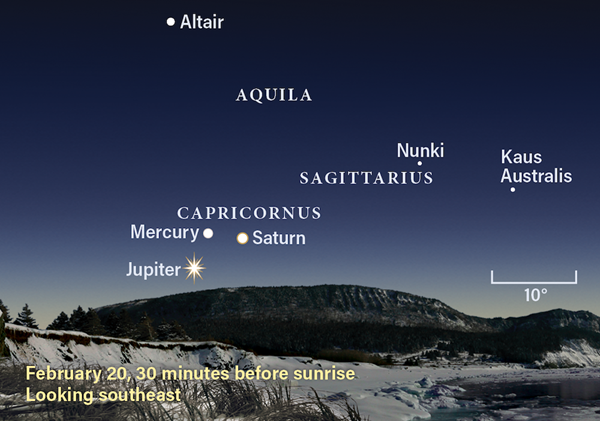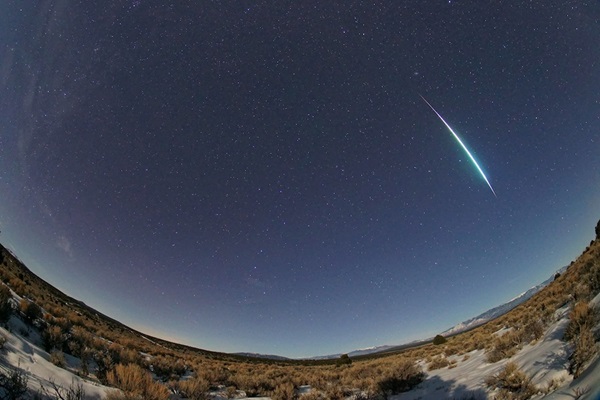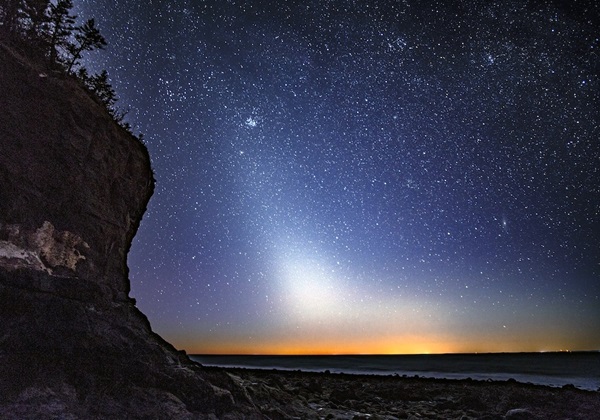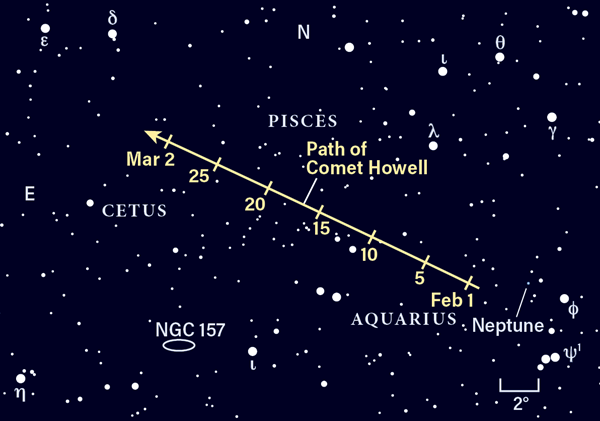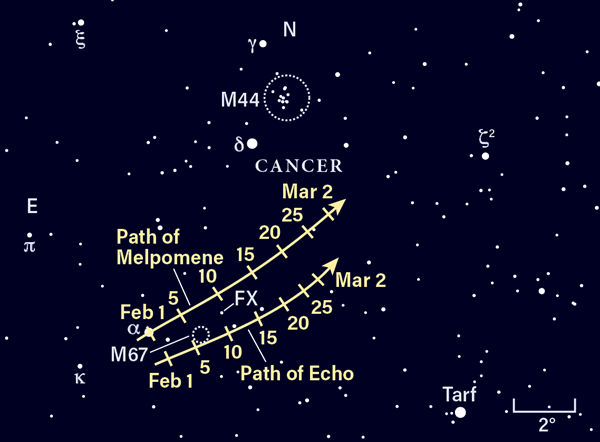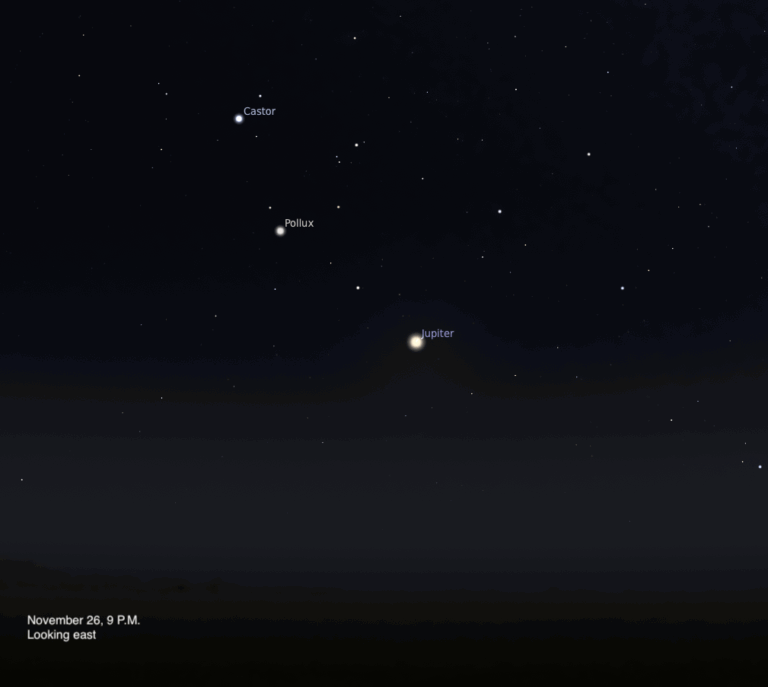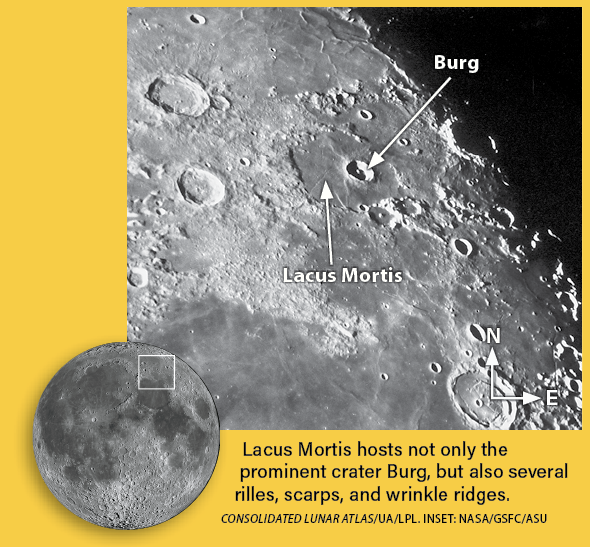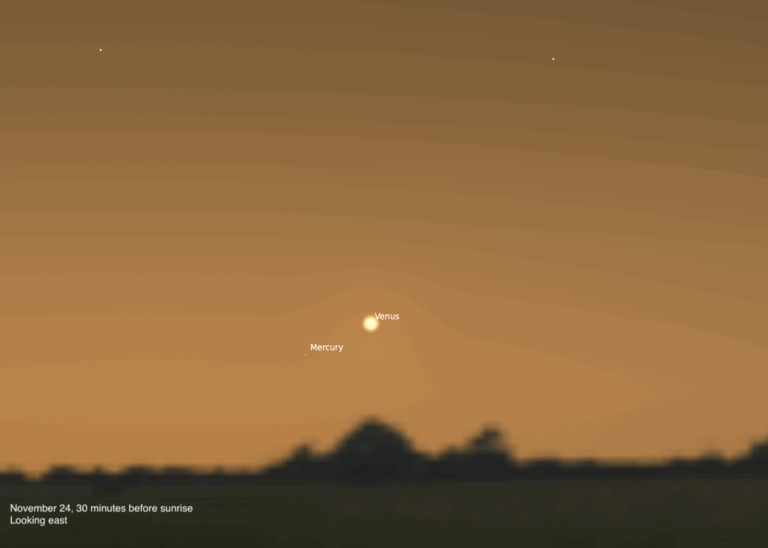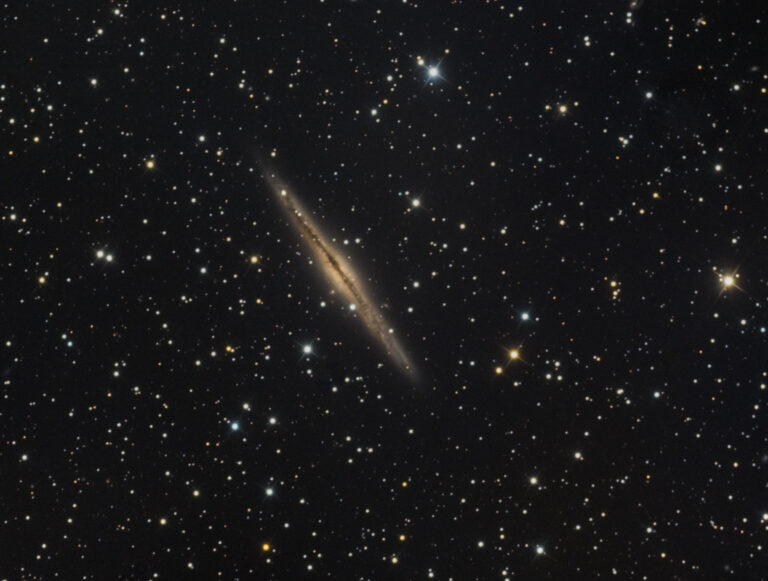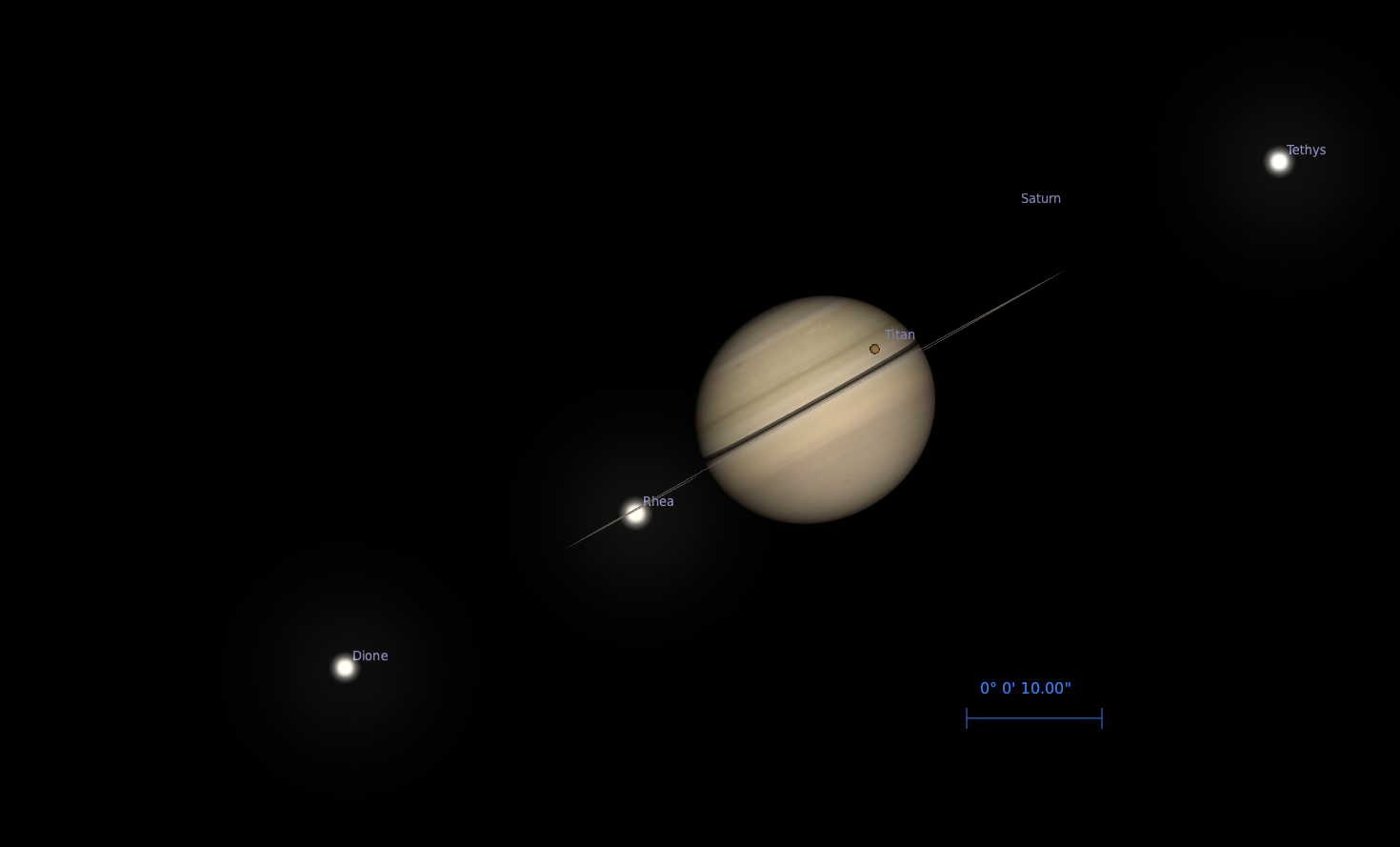Key Takeaways:
- February's morning sky offers views of Mercury, Venus, Jupiter, and Saturn, though some observations are challenging due to proximity to the sun and low altitudes.
- Evening observations include Mars in Aries (later Taurus), Uranus in Aries (observable with binoculars), and a brief appearance of Neptune in Aquarius.
- Specific planetary conjunctions are noted, including Venus and Saturn on February 6th, Venus and Jupiter on February 11th, and a triangle formed by Mercury, Saturn, and Jupiter around February 20th.
- The article also highlights opportunities for observing the Moon's libration, sporadic meteors, the zodiacal light, comets 88P/Howell, 17P/Holmes, and 141P/Machholz 2, and asteroids Melpomene and Echo.
The evening skies of February carry the distant giants Neptune and Uranus — Neptune is lost quickly in twilight, but Uranus lingers a while. Mars dominates the evening sky and enters Taurus this month. Although distant from Earth and showing a tiny disk, it will remain in our evening skies for a long while yet.
Attentive observers may catch Mercury February 1 in bright twilight after sunset. It’s a challenging view now, following its greatest eastern elongation late last month. Begin your attempt 30 minutes after sunset. Can you spot the magnitude 0.9 planet 6° high in the western sky? Watch with binoculars for 15 to 20 minutes as the sky darkens and Mercury dips lower. The planet descends quickly and 15 minutes before it’s gone, it stands 2° high — tough to spot at such a faint magnitude, but some observers with clear skies may have good luck. Locations with the best chance are those with fine atmospheric transparency offered by a high altitude and a clear view to the west. Mercury passes through inferior conjunction February 8 and springs into the dawn sky along with Jupiter — more on that later.
Mars and Uranus begin the month about 6.5° apart in the constellation Aries the Ram. Uranus is only visible with binoculars for most observers. At magnitude 5.8, it may be visible to the naked eye under exceptionally clear sky conditions. It lies 10.5° south of Hamal, the brightest star in Aries. A waxing crescent Moon lies within 5° of Uranus on February 17 and skips next door to sit 4° south of Mars on the 18th.
Through a telescope, Uranus displays a fine 3.5″-wide disk with a greenish hue on nights when stars are not twinkling badly — a sure sign of good seeing conditions.
Mars moves into Taurus February 23 and ends the month nearly 14° northwest of Aldebaran and nicely placed about 3° southwest of the contrasting blue stars of the Pleiades (M45).
The Red Planet presents a tiny disk through telescopes as its distance from Earth continues to increase apace. Its gibbous phase is a distinctive 90 percent lit. On February 1, it’s already 1.2 astronomical units from Earth (1 astronomical unit, or AU, is the average Earth-Sun distance). That distance increases to nearly 1.5 AU by February 28. The disk’s angular size shrinks from nearly 8″ to 6.4″ over the course of the month.
Features so familiar during Mars’ opposition late last year are now tougher to spot.
During the first five days of February, the darkest — Syrtis Major — swings into view in the evening between sunset and local midnight for most observers in the U.S. The lack of albedo features is apparent during mid-February, as desert regions transit the martian disk during our evenings. Solis Lacus and Sinus Meridiani, two distinctive dark features, are on view in the last week of the month, but the tiny disk makes them hard to spot except under optimum seeing conditions. Skilled observers who practiced video capture during last year’s opposition can still bring them out if conditions cooperate.
Venus, on its way to a late March superior conjunction, passes 26′ due south of Jupiter February 11. They’re located just 10.5° east of the Sun. Jupiter shines at magnitude –2; the pair may be seen in binoculars 20 minutes or so before sunrise, but will be very challenging. Observers, be very cautious — you can easily lose track of time as the Sun comes up. Protect yourself by setting an alarm to go off several minutes before sunrise. Never scan the skies after sunrise, because an accidental view of the Sun through binoculars will cause lasting damage to your eyes!
Observers with clear, transparent daytime skies and an accurately aligned telescope on February 11 can use their go-to device to find Venus and Jupiter in daylight.
On February 15, Saturn and Mercury rise together in the eastern sky, but remain difficult objects due to their relative faintness in twilight. By February 18, they stand roughly 3° high 45 minutes before sunrise. Mercury has brightened to magnitude 1.2, while Saturn remains easier at magnitude 0.6. The two planets’ visibility improves each consecutive morning.
Try on the morning of Saturday, February 20, to spot all three planets in a triangle: Saturn and Mercury rise together 4.4° apart around 5:40 A.M. local time, followed by Jupiter 7° east of Saturn about 22 minutes later.
Mercury and Saturn match in magnitude February 22, when they stand almost 5° high 40 minutes before sunrise. Jupiter stands less than 1° high, but its brilliance makes it more easily visible. It lies about 5° east (lower left) of Mercury, while Saturn stands 4° to Mercury’s southwest (right).
The triangle formed by this trio of planets flattens as Mercury drops in declination in late February, brightening as it does so. On February 28, it shines at magnitude 0.3 and stands only 3° west of Jupiter, with Saturn 5.5° to Mercury’s west. It’s amazing to get this view across the solar system — all three planets are currently on the far side of the Sun. Mercury is closest to Earth at 0.85 AU, while Jupiter is at 6 AU and Saturn is a distant 10.8 AU away.
If you’re able to swing a telescope towards these planets, you’re in for a visual — though short-lived — treat, since twilight is advancing quickly. Mercury displays a 46-percent-lit disk spanning 8″, whereas both Jupiter and Saturn are full. Jupiter spans 33″ and is accompanied by its four Galilean moons, just visible in the shimmering haze. Saturn’s disk is 15″ wide and its bright ring system spans 34″ at its widest.
Rising Moon: Lunar strongmen
Prominently paired craters Atlas and Hercules rule the lunar northeast. Without compare in strength, these mythological musclemen have appropriately striking features named after them.
Their chiseled forms seem to pop out on the 16th, lit by a rising Sun in the lunar sky. Atlas, the one closer to the limb, sports a rough floor and central peak. Just to the west, Hercules straddles the day-night line, the terminator. Over the next few hours, watch the long shadows slowly retreat. The western inner walls face the brilliant Sun, while their eastern sides remain dark. Return on the 17th to see the floor of Hercules — surprise! It’s a pool of frozen lava with the barest hint of a central peak and a sharp crater just off the bull’s-eye.
Each bowl is surrounded by an apron of debris. Under the low Sun angle, can you tell which one drapes over the other? Researchers disagree over which formed first. It may help to look with reversed lighting, when the setting Sun illuminates the craters’ eastern flanks on March 1, a few days after Full.
Luna slowly turns its nose up at us beginning on the 17th. Key in on the limb northeast of Hercules and watch the dark floor of Mare Humboldtianum shift out of sight from night to night. The Moon’s axis does not actually tilt — as it bobs up and down in its orbit around Earth, we see it from slightly different points of view. Astronomers call this apparent nodding motion of our satellite libration.
Any time after First Quarter (the 19th), we’re close to lunar high noon for both Atlas and Hercules. Without the shadows, Atlas practically disappears. In contrast, Hercules’s lava lake stands out well against its neighboring light-hued crater. Pay close attention — Luna reveals a different face every night.
Meteor Watch: A dim, dusty glow
with no major showers, February is traditionally a quiet month for meteors. The average sporadic (random) rate for meteors is seven per hour and there are occasional fireballs — meteors that break up and achieve a brilliance of Venus or greater. These are, of course, rare, but worth spending time under a night sky ready for their appearance.
The zodiacal light begins to make an appearance during moonless nights in February, March, and April. The evening view of this subtle glow, which arises from the meteoritic dust that fills the plane of our solar system, gets better as the ecliptic becomes more steeply inclined to the horizon. The first two weeks of February are favorable, with the Moon in the morning sky. As soon as the Milky Way becomes visible — arching from high up in Perseus through Orion and toward the southern horizon — look for a faint, cone-shaped glow of light reaching up from the western horizon through Pisces, Aries, and into Taurus at its narrowest. The zodiacal light is never seen from cities or towns, but is visible from country locations with dark skies to the west.
Comet Search: Challenge versus chance
Comet enthusiasts are used to excitement, disappointment, and satisfaction all in one month. No one can be sure which it will be this spring. As Earth circles the inner solar system, some comets coincidentally arc behind the Sun, popping into visibility with only three months’ notice before they peak, missing our publication deadline.
Surprising us twice since its discovery, 17P/Holmes has outburst to 2nd magnitude. Cruising in front of the circlet of Pisces, will it shine anew? Meanwhile, as 141P/Machholz 2 sails from Cetus to Orion, its last fragment might flare up to 10th magnitude for a final show.
With great but not absolute confidence, we expect Comet 88P/Howell to present a challenge for an 8-inch scope under a dark sky. Once you’ve confirmed the starfield is right, pump up the magnification to about 200x. Get comfortable, dark adapt as much as possible, and patiently scan for a very small fuzz — picture a 13th-magnitude elliptical galaxy. Tapping the scope gently can leverage our eyes’ low-light motion-detector system, while also suppressing “phantom galaxies” produced by a noisy visual cortex.
The best comet hunting this month is during the moonless first half of February.
Locating Asteroids: Buzzing the Crab
It’s two-for-one asteroids this month. Floating only one field apart, 18 Melpomene and 60 Echo track across southern Cancer. The celestial crab is well placed one-third of the way up the eastern sky once darkness sets in. This aquatic constellation boasts the splashy Beehive Cluster (M44); start with this showpiece, then shift a few degrees south to Alpha (α) Cancri and M67.
From the 5th to the 8th, magnitude 10 Echo shares the medium-power field with the well-studied cluster M67. Melpomene is just over 1° to the north and is a bit brighter at magnitude 9.5. Crank the power to the max on M67 and test your limiting magnitude against the chart in the Royal Astronomy Society of Canada’s Observer’s Handbook or one generated online at the American Association of Variable Star Observers’ website, www.aavso.org.
Until much brighter 4 Vesta arrives in spring, we must be meticulous in our identification of these main-belt asteroids. Starhop carefully, sketch a field in the expected area, then come back a night or two later to see which dot has moved. The orange star FX Cancri varies only slightly from magnitude 6.7, making a nice reference in the same field.
Thanks to the longer nights of February, you might be able to see these small worlds move slightly over a four-hour session.


